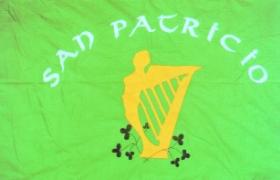Soldiers and mercenaries
Published in 18th–19th - Century History, Early Modern History (1500–1700), Features, Issue 4 (Jul/Aug 2008), Volume 16
A replica of the San Patricio flag, presented to President Mary Robinson in September 1997. (Clifton Historical Society)
Irish soldiers active in the region by the end of the eighteenth century and during the wars of independence were members of British, Spanish, Portuguese and South American armies. In the eighteenth century the Spanish regiment Ultonia, with Irish origins in Catalonia, was stationed in Mexico. In Chile, the Spanish Crown appointed Ambrose O’Higgins of County Sligo as governor, and later as viceroy of Peru. His son Bernardo would became a national hero of the Chilean struggle for independence . . . from Spain!
In 1762 the British attacked Colonia del Sacramento in Uruguay, but failed when their flagship blew up, killing several Irish soldiers. In 1806 and 1807, during the British campaigns against colonial Buenos Aires, a significant number of soldiers were Irish. The campaigns failed and the invaders were repulsed, but some of the prisoners and deserters settled and prospered in Argentina, and played a role in early migration from Westmeath to this region.
During the South American wars of independence, the Irish saw military action as legionaries in Simón Bolívar’s army, and fought in Venezuela, Colombia, Panama, Ecuador, Peru and Bolivia. The Irish Legion of John Devereux, supported by Daniel O’Connell, arrived in Venezuela in 1817 but soon mutinied and was devastated by epidemics. Bolívar said he was ‘pleased to be rid of these mercenaries who would do no killing until they had first been paid for it’. Other Irish soldiers fought with honour and were recognised for their gallantry, like Francis Burdett O’Connor and Daniel Florence O’Leary. In Argentina, William Brown created the navy that broke the Spanish blockade, and John Thomond O’Brien engaged in battle in Chile and Peru. Other Irishmen who fought for the new republics were Thomas Charles Wright of Drogheda, Peter Campbell of Tipperary, Patricio Lynch (a naval hero in Chile), Diago Nicolau Keating, Diago O’Grady and Jorge Cowan, who served in Brazilian armies.
The most celebrated Irish military exploit in Latin America was that of the Batallón San Patricio of the Mexican army against the United States in 1846–8. Led by John O’Reilly of Clifden, Co. Galway, hundreds of Irish and other US soldiers deserted to the Mexican side and fought under a green banner with an Irish harp and shamrock. The ‘San Patricios’ distinguished themselves in the battles of Buena Vista and Churubusco. At the end of the war they were captured and court-martialled, and 30 were hanged. Their bravery is widely known among Mexicans today. Understandably, they were regarded as traitors in the US.
















